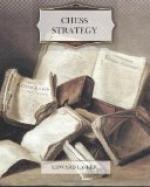It is first necessary to ascertain a few leading principles, which can be taught in a most simple manner, by the exercise of common sense, rather than by applying oneself to the study of long-winded analysis. The student will no longer need to discover time-worn maxims in the light of his own weary experience, and on the other hand, these principles will help him to understand analysis, and to keep clearly before his mind’s eye the common and principal lines of play, of which he might easily lose sight in the labyrinth of suggested variations.
I propose to show the application of such principles to master play, and this will give us a further opportunity of deeper study, both of the rules set out in the first part for conducting the opening correctly, and of the end-game principles, which should be well considered.
I have made the pawn skeleton with its attendant grouping of pieces the main consideration in the study of the opening; now in the investigation of the problems of the middle game, I will start from the transformation which the pawn skeleton has to undergo in the course of further operations. In my opinion this is the best starting-point for the choice of effective manoeuvres of the different pieces.
Before we are able to evolve a practical scheme we must have under consideration the following important points: How do we know if an attack is likely to succeed? In other words: On what point should I concentrate the attack? It should be clear to all that it is of no possible use to direct an attack on anything that can move away. Yet beginners frequently infringe this obvious rule, and I have often witnessed manoeuvres such as these (Diagram 90):
--------------------------------------- 8 | #R | | #B | #Q | | #R | #K | | |---------------------------------------| 7 | #P | #P | #P | | | #P | #P | #P | |---------------------------------------| 6 | | | #Kt| #P | | #Kt| | | |---------------------------------------| 5 | | | #B | | #P | | | | |---------------------------------------| 4 | | | ^B | | ^P | | | | |---------------------------------------| 3 | | | ^Kt| ^P | | ^Kt| | | |---------------------------------------| 2 | ^P | ^P | ^P | | | ^P | ^P | ^P | |---------------------------------------| 1 | ^R | | ^B | ^Q | | ^R | ^K | | --------------------------------------- A B C D E F G H
Diag. 90
1. P-QR3, 2. P-QKt4, and then, after the B has retired to his Kt3 even, 3. R-QKt1, 4. P-QR4, 5. P-R5. Meanwhile Black will have played P-QR3, to make a loophole for his B at R2, and what is the result? The Black Bishop is as effectual at R2 as at B4, but White has advanced his pawns, and weakened them, as they are now more liable to attack. Moreover, White has used up five moves to achieve his aim, whilst Black only needed three. Therefore Black has gained two moves, which he can use for the development of his pieces.




